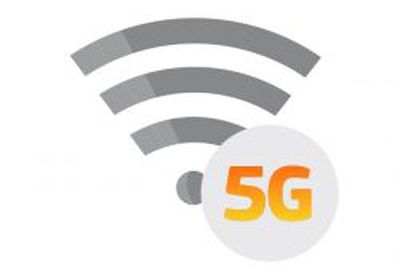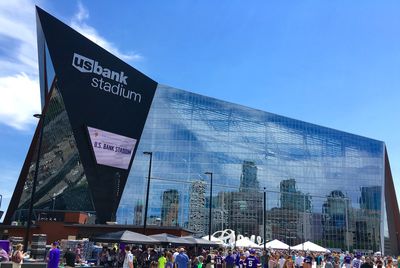 AT&T this week announced that it plans to launch its "5G Evolution" network in parts of Minneapolis over the next few months, intending to provide next-generation cellular coverage to customers at Super Bowl LII. AT&T didn't mention which specific areas of Minneapolis would be covered by February 4, 2018, but confirmed "areas near the host stadium" will have 5G at the time.
AT&T this week announced that it plans to launch its "5G Evolution" network in parts of Minneapolis over the next few months, intending to provide next-generation cellular coverage to customers at Super Bowl LII. AT&T didn't mention which specific areas of Minneapolis would be covered by February 4, 2018, but confirmed "areas near the host stadium" will have 5G at the time.
Minneapolis is the next leg in AT&T's 5G rollout, and one of 20 markets where the carrier is planning to bring 5G Evolution by the end of 2017. The technology is already available in parts of Austin and Indianapolis, and allows customers access to much faster speeds on compatible devices, which as of now does not yet include any iPhone model.
“We’re excited about launching this new wireless network in Minneapolis in the coming months as we move towards standards-based mobile 5G,” said Marachel Knight, senior vice president, Wireless Network Architecture and Design. “The upgrades we’re making today in Minneapolis are the foundation for the future of next generation connectivity in this city.”
“Minnesota is in a great position to welcome 5G Evolution wireless technology, with a climate that encourages the deployment of small cells – an integral building block for 5G,” said State Senator Bobby Joe Champion. “Good public policy can help put Minnesota on the map and attract investment that will prepare our state for the next generation wireless economy.”
In addition to the upgraded network in and around Minneapolis, AT&T will also upgrade the Distributed Antenna System (DAS) at the U.S. Bank Stadium in downtown Minneapolis, where Super Bowl LII will be held. The company said this means the stadium will be "overloaded...with wireless capacity and boosted LTE capacity" by an increase of 150 percent compared to last year, thanks to more than 800 antennas.
AT&T mentioned that Minneapolis is a "major step" on its journey to make 5G a standard for mobile networks "as soon as late 2018." In total, the locations focused on AT&T's 5G rollout will result in "smarter cities," according to the company, as well as support for higher quality augmented and virtual reality experiences on smartphones.

Right now, 5G-capable devices include LG V30, Moto Z2 Force Edition, Samsung Galaxy Note 8, Samsung Galaxy S8, Samsung Galaxy S8+, and the Samsung Galaxy S8 Active. These smartphones can take advantage of ultra-fast LTE Advanced features including 256 Quadrature Amplitude Modulation, 4x4 Multiple-Input and Multiple-Output, 3-way carrier aggregation, and other 5G-related upgrades, to provide faster network speeds to users.
Sprint, T-Mobile, and Verizon have also announced interest in 5G networks, with Sprint saying its own wide-scale 5G network will launch by 2019, and T-Mobile aiming for nationwide 5G coverage by 2020. Of course, all of this progress hinges on the 3rd Generation Partnership Project first completing the 5G Release 15 standard. According to AT&T, once Release 15 is out then 5G-supported "commercial equipment" will be available within six months.
Earlier this year, Apple submitted an application to the FCC for an experimental license to test next-generation 5G wireless technologies, which it was then granted in July. While the exact purpose of Apple's tests remains unclear, the company could be looking to prepare future models of its iPhone and iPad devices to take advantage of 5G network speeds.






















Top Rated Comments
See how that works?
There isn’t even a 5G standard yet- they’re still defining it. I can’t stand the buzzwords the carriers use to describe their networks. Just call them what they are- LTE, LTE-A (true 4G), etc. People aren’t stupid- they can learn the real names for the different standards.
"Right now, 5G-capable devices include LG V30, Moto Z2 Force Edition, Samsung Galaxy Note 8, Samsung Galaxy S8, Samsung Galaxy S8+, and the Samsung Galaxy S8 Active."
[doublepost=1510754534][/doublepost]Shiny new original $499 iPhone (an unheard of sum for a phone in '07) didn't support 3G. People still bought and loved. It's not like 4G sucks or that 5G is here today. It won't truly be up and running for at least a couple of years. By then the X will be "old" anyway.
I get why non-gadget freaks spout this kind of BS. Unsure why people who love tech do. It's the nature of being an early adopter and appreciating tech for what it can do today.
5G in reality is a huge densification effort that combines a heavy amount of smaller cells (and macro to add into the mix) and a boatload of extremely high frequency to supplement the current swath of lower frequencies used by carriers.